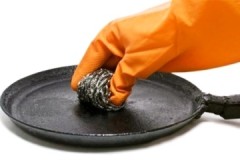Advice from experienced housewives on how to remove carbon deposits from the outside of a frying pan at home
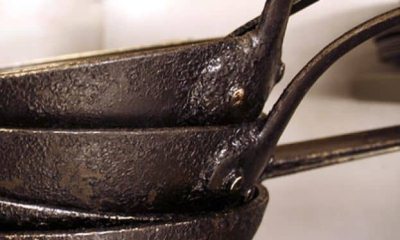 Active use of the frying pan leads to the formation of deposits of fat and food debris on its outer side.
Active use of the frying pan leads to the formation of deposits of fat and food debris on its outer side.
Under the influence of high temperatures, it hardens and eats into the walls and bottom, which can cause an unpleasant odor and the dishes will not heat up evenly.
Read the article about how to quickly and effectively remove carbon deposits from the outside of a frying pan at home.
Content
How to cleanse using traditional methods?
To get rid of old carbon deposits, use a recipe based on 3 components:
- soda,
- laundry soap,
- silicate glue.
Procedure:
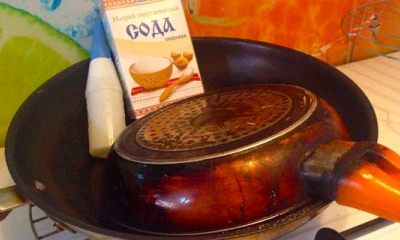 Place a large enamel basin on the fire, into which a frying pan will fit.
Place a large enamel basin on the fire, into which a frying pan will fit.- Fill it with water and bring to a boil.
- Add a grated bar of laundry soap to the water, ? cups of silicate glue and ? glasses of caustic soda. You need to pour the glue in a thin stream so that it does not curl.
- Lower the frying pan into the boiling solution and leave on low heat for 15 minutes, then turn off the gas. Wait for the water to cool down.
- Remove carbon deposits from the pan with a soft brush.
- Rinse the dishes with clean water.
As the solution boils, a chemical smell will appear, so the procedure should be carried out in a room with good ventilation.
Under the influence of high temperatures, carbon deposits will peel off from the surface of the cookware.. However, this method is only suitable for processing a cast iron frying pan.
You can deal with carbon deposits using citric acid. It is used to process products made of cast iron and stainless steel.
Mode of application:
- Prepare a solution based on citric acid and dishwashing liquid. For 1 liter of water you will need 1 tablespoon of lemon and 1 teaspoon of gel.
- Soak the pan in the solution for an hour.
- Treat it with a brush and rinse with clean water.
This method is not suitable for caring for aluminum or Teflon-coated products.
The video will show you how to clean a frying pan from carbon deposits:
Special means
If the carbon deposits are old, then you can deal with it using special means. They are sold in household chemical stores and online markets. Top 3 best lineups:
Kitchen DutyBox
This is a concentrated cleaner for combating complex stains. It includes:
- surfactant,
- organic solvent,
- complexing agent.
Before use, the base must be diluted with warm water. The grease and carbon remover is applied through a sprayer, which saves its consumption. Price – 205 rubles per package.
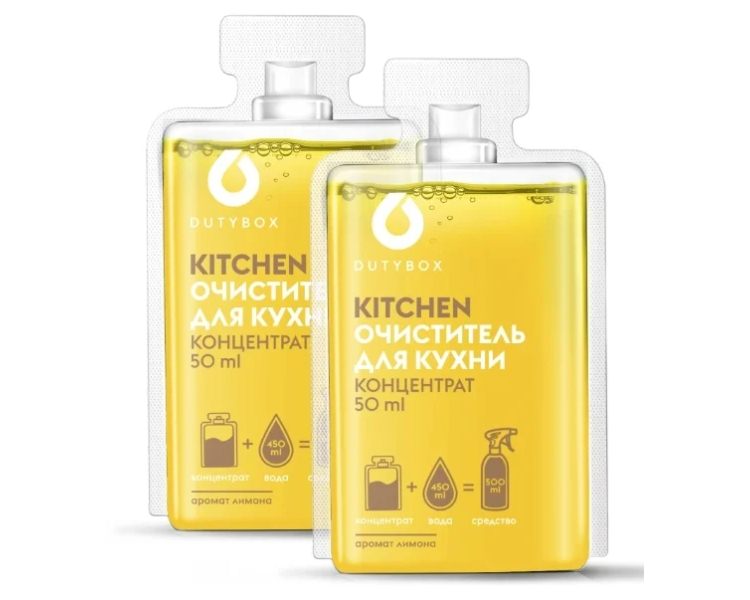
Miracle Express from Himitek
The spray copes with stubborn and burnt fats, soot and carbon deposits. The composition is intended to care for:
- dishes,
- slabs,
- grills,
- ovens.
Price – 350 rubles.
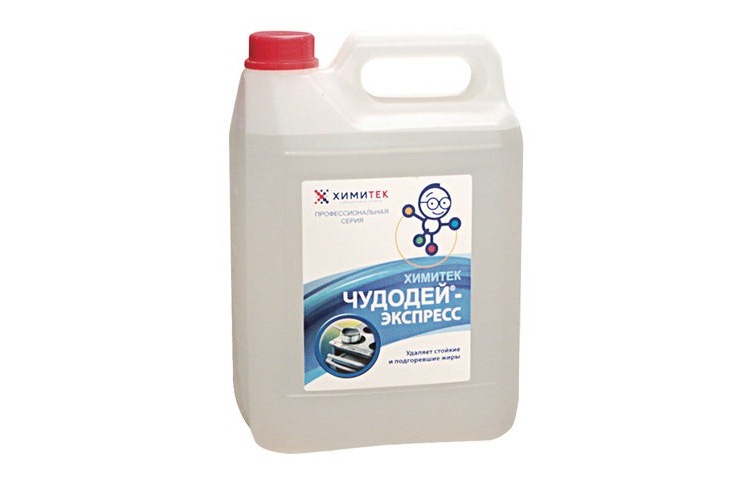
Kitchen spray Chistin Professional
The manufacturer promises instant results. For moderately complex stains, it is enough to leave the spray for 20 seconds, and to remove stubborn deposits, leave it on the surface for 1 minute. After treatment, the composition is washed off with water.
The formula is based on a mixture of solvents, alkali and surfactants.Price – 280 rubles.
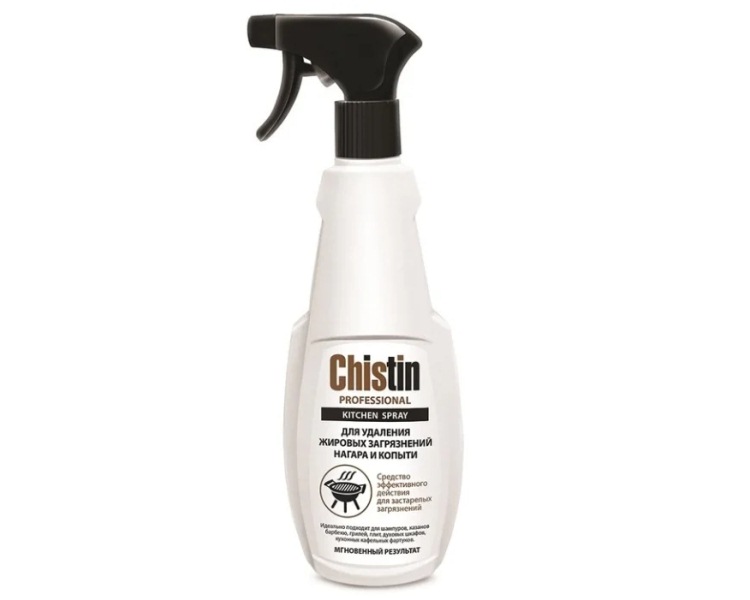
When choosing a cleaning product, you need to pay attention to the following points:
- You should not buy products for universal use, as they do not give the desired effect. It is better to leave your choice on the composition marked “from carbon deposits”.
- It is more convenient and safer to use liquid formulations. They are free of abrasive particles that can leave scratches.
- When purchasing, specify for which surface the composition is intended, since frying pans are made of different metals. Cast iron cookware cleaner most often cannot be used to clean nonstick cookware.
- If the packaging is equipped with a dispenser, then it is better to choose this particular composition. It will be spent more economically.
- The product should be suitable for caring for surfaces in contact with food, despite the fact that the frying pan will have to be cleaned from the outside.
Mechanical cleaning
You can clean the pan mechanically. To do this, use a metal scraper or an iron brush.
 Procedure:
Procedure:
- put gloves on your hands;
- heat the pan;
- place it on a flat, non-slip surface (so that after cleaning you don’t have to collect burning particles; cover the tabletop or floor with newspapers);
- walk along the outside of the product with a brush;
- rinse the dishes.
As the pan cools, it is heated again. The procedure is repeated until a visible result is achieved.
You can speed up the process using a grinder. Mechanical cleaning is not suitable for caring for Teflon, aluminum and ceramic cookware.
Sometimes regular sand is used instead of metal brushes. It acts as a powerful abrasive that effectively removes carbon deposits. Rub the outside of the pan with it until completely clean.
What not to do and why?
Basic prohibitions:
- If the cookware is made of aluminum or cast iron, then it should not be rubbed too hard with abrasives or metal brushes. They will cause scratches, which will quickly become filled with dirt.
- Non-stick pans can only be washed with liquid detergents. Remove dirt with a soft cloth or sponge. It is prohibited to heat such products.
- Ceramic frying pans should not be treated with powders or rough bristled brushes.
- Cast iron pans should not be washed in the dishwasher.
- Aluminum cookware should not come into contact with alkali. It can be treated with acids, but with great caution.
Helpful information
Tips for removing carbon deposits from the outside of a frying pan:
 Before you wash your non-stick or ceramic frying pan, you need to let it cool. Such dishes do not tolerate temperature changes.
Before you wash your non-stick or ceramic frying pan, you need to let it cool. Such dishes do not tolerate temperature changes.- When choosing a method for cleaning a frying pan, you need to consider what material it is made of. Teflon-coated products will not withstand mechanical cleaning or heat treatment.
- After using any composition, the frying pan must be thoroughly washed in running water.
- When using caustic substances, do not allow them to come into contact with the working surface of the frying pan.
- Before using a new product for the first time, you need to test it on a small area.
Useful information on ways to remove carbon deposits from a cast iron frying pan - in this article.
For methods and means of cleaning pans made from various materials, read this section.
Conclusion
You can remove carbon deposits from the outside of a frying pan in different ways:
- using improvised means,
- household chemicals,
- thermal or mechanical treatment.
When choosing the optimal method, they start from what metal the frying pan is made of and what coating is applied to it. A prerequisite for quality cleaning is compliance with the instructions.
